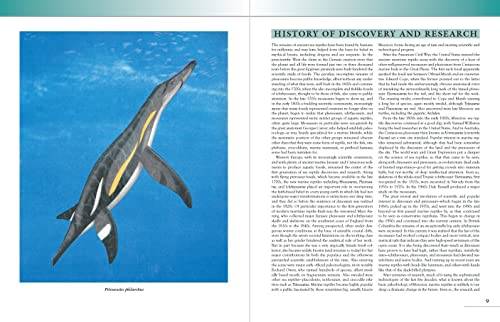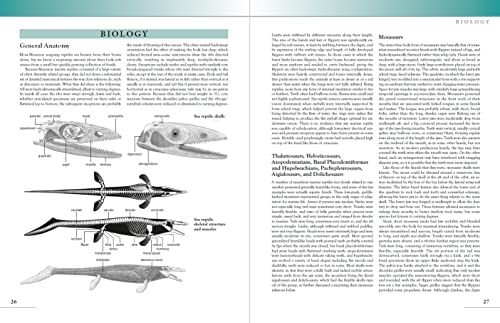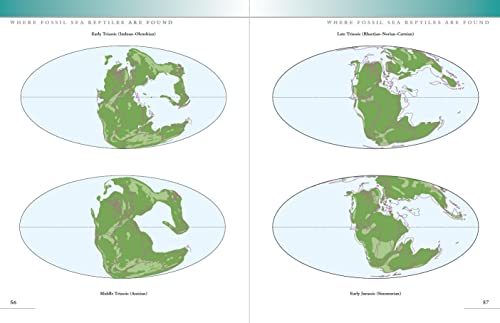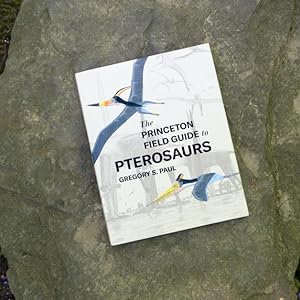




Princeton University Press The Field Guide to Mesozoic Sea Reptiles






V**N
The first genuine field guide to Mesozoic marine reptiles ever
Given that Gregory Paul has written field guides about non-avian dinosaur and published a field guide to pterosaurs last year, I didn't think he would publish a book about Mesozoic marine reptiles in October of last year because he's more interested in dinosaurs than any other group of Mesozoic diapsids. Nonetheless, Paul does an excellent job of providing species accounts for multitude of marine reptile species that lived during the Age of Dinosaurs, including plesiosaurs, ichthyosaurs, thalattosaurs, nothosaurs, placodonts, mosasaurs, thalattosuchians, marine turtles and snakes, and hupehsuchians. It's good that Greg Paul himself accepted the recent taxonomic scheme for teleosauroids adopted by Michela Johnson and colleagues, because the long temporal range created by several species once assigned to Steneosaurus indicated that putative synonyms of that genus were almost certainly distinct in their own right (the type species of Seldsienean, S. megistorhynchus, was erroneously regarded by a few authors as fulfilling the function of Steneosaurus type species because they noted that hypodigm for Steneosaurus rostromajor comprised two taxa, the snout belonging to a machimosaurid teleosauroid similar to Neosteneosaurus edwardsi and the skull fragment being metriorhynchid, but S. rostromajor still stands as the type species of Steneosaurus, and I'm glad that Michela Johnson and Mark Young recognized this fact given that Seldsienean is older than Steneosaurus and Neosteneosaurus). It's also noteworthy that this book follows Leslie Noe in treating the kronosaur specimens on display at Harvard University as its own genus and species, Eiectus longmani, and also separate from Kronosaurus queenslandicus (restricted to diagnostic material from the type horizon of K. queenslandicus from the Toolebuc Formation), because even though some people criticized Noe for not asking the ICZN to designate a neotype for Kronosaurus, the older age of Eiectus compared to the type horizon of the Kronosaurus queenslandicus holotype and referred specimens from that horizon mean that Kronosaurus is not going away, and Noe probably wanted to make the point that the treatment of diagnostic Kronosaurus remains from the type horizon of K. queenslandicus as the same species as Eiectus longmani is no longer tenable due to multiple pliosaurid species existing in the Paja Formation in Colombia. There are, however, a few taxonomic opinions expressed by Paul in this field guide that I disagree with:1. Although Palatodonta is known from a juvenile specimen, Paul's treatment of this genus as being an individual of Pararcus would mean that Palatodonta has priority, and the authors of the paper in which Pararcus is described indicate that the Pararcus holotype probably isn't an adult individual despite being of large size, and the truth of the matter is that Palatodonta and Pararcus are still basically distinct taxa no matter if the holotypes of these genera are non-adult (a similar situation happened with Bellusaurus and Klamelisaurus because Klamelisaurus was considered on occasions a probable adult Bellusaurus due to the small size of known Bellusaurus specimens, but research by Andrew Moore has demonstrated once and for all that Bellusaurus and Klamelisaurus are distinct sauropods because there are morphological differences between those two taxa that are non-ontogenetic).2. Paul's listing of Cymbospondylus species in this book as an unnamed genus is unwarranted and threatens the nomenclatural stability of the genus Cymbospondylus because that name has been widely used in the literature, and he overlooks the fact that Cymbospondylus piscosus is the type species of the genus and that Cymbospondylus nevadanus is the only Cymbospondylus specimen from the type locality of C. piscosus, in which case nevadanus could be a synonym of C. piscosus.3. Platypterygius platydactylus still stands as a valid taxon, no matter if its holotype was destroyed in WW2 and regardless of some Platypterygius species now being recognized as probably distinct genera (Paul himself elevates the subgenera Tenuirostria and Longirostria for Platypterygius americanus and P. australis to full genus rank in recognition of future study potentially confirming those species as generically distinct from P. platydactylus and P. hercynicus).If anyone's interested in Mesozoic marine reptiles, this book is a must read.
E**L
Great Reference
This book is all it’s cracked up to be in regards to having the latest information about every species of Mesozoic marine reptile. But, being a Greg Paul fan, I have to say most of the art here seems a little crude and rushed. Still a recommend, but don’t expect to be blown away by every illustration.
S**A
Très bonne série
Quelques petites coquilles, sûrement corrigées sur la prochaine édition, mais c'est toujours clair, passionnant et on attend le quatrième !
K**C
Magnificent coverage of marine reptiles.
Each species gets a brief overview of characteristics,diet,habits,lifestyle,range and more along with excellent color profiles(some of which are skeletal reconstructions,not full-color)and several full-page artworks of select examples within each group. Everything you would expect from a modern-day field guide but this time dealing with creatures long extinct.
J**Z
An excellent guide to marine reptiles great and small...
I had to order this book twice, only due to an error that was caused by the order confirmation on this site. A most worthwhile book, this is a perfect tome on the marine reptiles of the age of the dinosaurs, covering ichthyosaurs, plesiosaurs, mosasaurs, sea turtles, sea snakes and bizarre Triassic forms like placodonts and Atopodentatus. Its illustrations provide an excellent idea of how many if not most marine reptiles looked, and its text is informative, explanatory, and fairly easy to understand. I've learned a lot from it, and it serves as perfect reference material for my illustrations, writings, and sketch work. My rating: 5 out of 5 stars.
Trustpilot
2 weeks ago
1 month ago
2 weeks ago
1 month ago